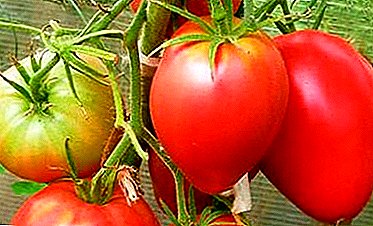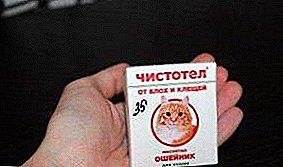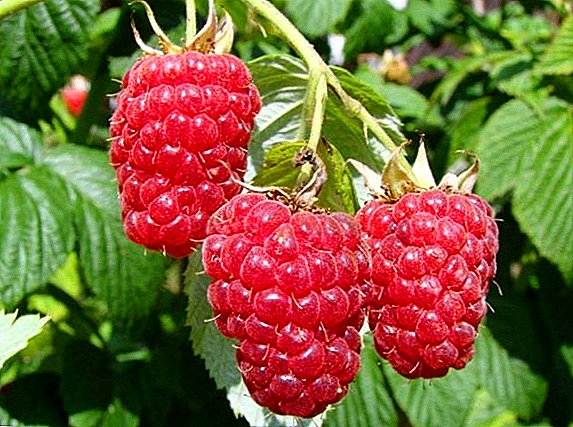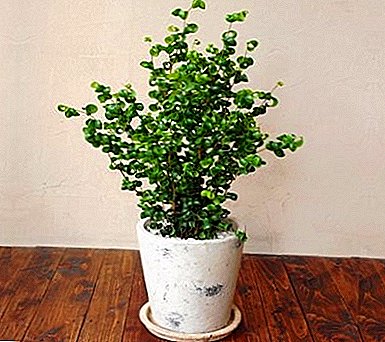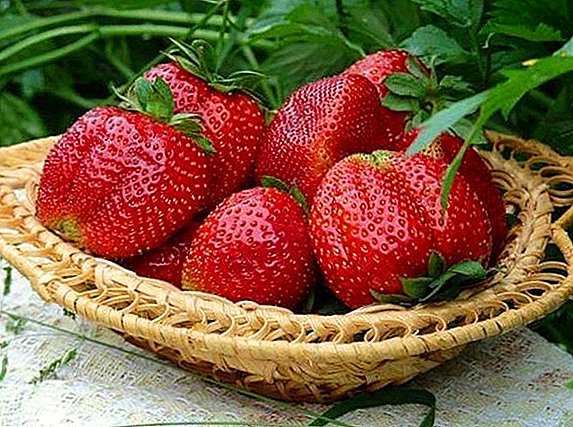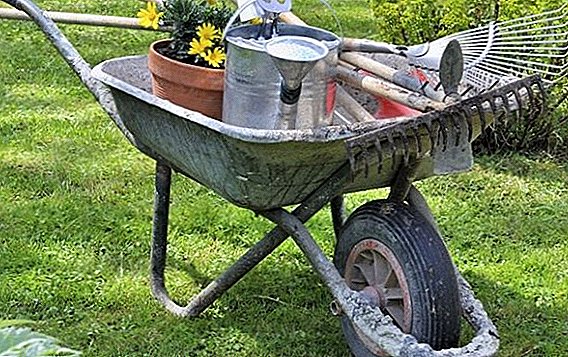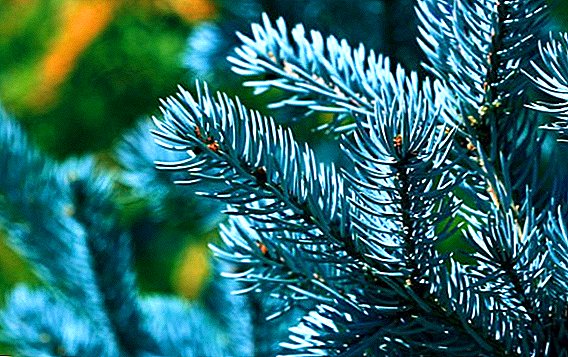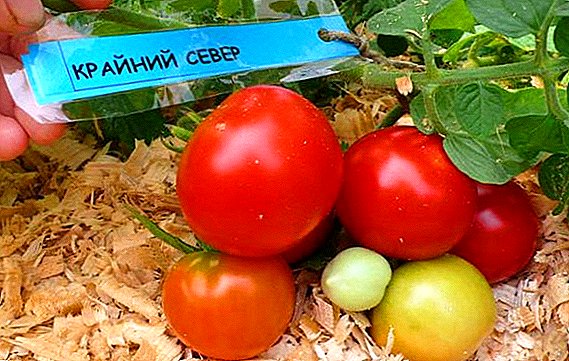 One of the problems faced by summer residents is the choice of a variety of garden plants, which will successfully grow and bear fruit in a certain climatic zone.
One of the problems faced by summer residents is the choice of a variety of garden plants, which will successfully grow and bear fruit in a certain climatic zone.
Especially often difficulties arise in those who live in cold regions.
In this article we want to introduce you to one of the cold-resistant varieties of tomatoes. Speech - about the "Far North".
Variety description
Tomato "Far North" refers to varieties characterized by early ripening - the fruits can be collected after 3 months after the emergence of seedlings.
To early ripe varieties of tomatoes include such as "Samara", "Explosion", "Bokele", "Kiss of Geranium", "Caspar", "Batyan", "Labrador", "Troika".
This tomato tolerates low temperatures and at the same time gives its owners good yields. 
Bushes in this plant are low - reach a maximum height of half a meter. They are compact, not overgrown. Because of this, more plants can fit on one square meter than, for example, other varieties.
The leaves at the "Far North" are medium in size. A small amount is formed on the bush. The shoots are located on a strong stalk, which ceases to grow at a time when 6 simple inflorescences form on the bush.
The main advantages of the variety are:
- high frost resistance;
- compactness;
- early terms of ripening;
- no need for pinching and garter;
- good fruit taste;
- universal purpose of the fruit;
- the ability to grow in cool and cold areas;
- increased resistance to the main diseases for this type of garden plant, in particular, to the apical and root rot;
- late blight independence;
- possibility of cultivation in open ground, hotbeds and greenhouses.

This variety does not require much effort for planting and care, so it can be grown by newbies in the dacha business.
Did you know? Since the importation of tomatoes in Europe in the XVI century for about a century, they were considered inedible and were grown as ornamental plants. The first recipe for their preparation was published in a cookbook published in Italy in 1692.
Fruit characteristics and yield
The fruits of the "Far North" are not large, reaching a mass of 50-80 g. They are round in shape, slightly elongated. To taste sweetish. The peel of well-ripened tomatoes is dark red and smooth. The flesh is juicy, medium density. Inside the tomatoes 4-6 cameras.
Fruits are characterized by versatility - suitable for fresh consumption, decoration of dishes, and for processing for juice, preservation. 
They contain high levels of sugars, fiber, proteins, pectins, organic acids, minerals, among which are calcium, magnesium, iron, phosphorus, iodine, and vitamins - carotene and lycopene, C, B, K, nicotinic and folic acid.
Also the dignity of tomatoes "Far North" is their excellent transportability. Mass maturation occurs 93-95 days after germination. - from about the end of July to the end of August.
The yield of one bush is 1.2 kg per season. With 1 square meter of planting can be collected about 2 kg of tomatoes. If you carefully monitor that carried out all of the following measures for the care, then from one bush you can get a crop of 2.5 kg.
Selection of seedlings
Of course, it is best to grow tomatoes from beginning to end on their own. However, if there is no possibility of planting and germinating seedlings, then it will have to be purchased on the market.  In this case, it will not be superfluous to know how to choose the right quality shoots. The choice should be based on the external qualities of the shoots.
In this case, it will not be superfluous to know how to choose the right quality shoots. The choice should be based on the external qualities of the shoots.
So, the seedlings should be:
- age 45-60 days;
- no more than 30 cm high;
- with 6-8 true leaves that have a beautiful green color and a healthy appearance;
- with an intact, well-developed root system;
- stem diameter of 5-7 mm;
- without formed fruits.
When choosing, you should carefully examine the areas under the leaves for the presence of harmful insects.
It is necessary to abandon plants that have:
- saturated green leaves, twisted down - this is a sign that the shoots were nourished with nitrogen;
- leaves are deformed, shriveled, twisted - evidence of diseased plants.

It is advisable to purchase seedlings from trusted vendors that you trust. Otherwise, you should collect as much information about it from the implementer. Seedlings can be sold both in containers and with an open root system. The first has a higher percentage of survival rate and higher cost.
Did you know? In the Guinness Book of Records, among other records, are collected and agricultural achievements. One of the champions is a tomato, which was given the nickname Big Zak. The 3.8-pound giant fruit was grown by Dan McCoy, an American.
Soil and fertilizer
An important condition for the successful cultivation of tomatoes is the preparation of the soil. And it is essential both for seedlings, and for adult plants, planted in the main growing area.
The seedlings will require a loose, light soil that has good air and moisture conductivity. 
The composition may be as follows:
- turfy or vegetable soil (part 1);
- peat (2 parts);
- river sand (0.5 parts);
- humus (2 parts) or compost (1 part);
- wood ash (1 cup per pail) or dolomite flour (3-4 tablespoons per pail mix).
To achieve good breathability, you can add a little sphagnum moss.
Important! The soil before planting seedlings should be disinfected by roasting in the oven or steaming in a double boiler.
On beds, sandy soil with an acid level not exceeding 6.5 pH is desirable. It is better if earlier cabbage or cucumbers were placed on it. It is not recommended to plant tomatoes in one place two years in a row, as well as after pepper, eggplant, potatoes. 
Preparation of the soil should begin in the autumn - it will need digging and adding organic matter: humus or compost. In the spring, just before planting the seedlings, mineral supplements should be added to the ground. This may be potassium chloride or superphosphate.
Growing conditions
Tomatoes are heat-loving plants, therefore the area for planting them should be selected sunny and covered from drafts.
If cultivation takes place in covered constructions, then the optimum temperature for successful and harmonious seed germination is + 20 ... +25 degrees, for growth of the sprouted sprouts - + 14 ... +16 during the day and not less than 10 at night.
Maximum yields can be achieved if the beds will be at a temperature of + 20 ... +26 ° C during the day and not below +16 ° C at night. 
Important! If the thermometer falls below +10 ° C either rises above +35 ° C, the tomato bush stops growing. Sharp temperature drops are also destructive for the plant.
When growing tomatoes to achieve absolute soil moisture is optional. They are sufficiently drought-resistant and can tolerate short-term lack of moisture without detriment to development. However, maximum yield can be achieved only by regularly moistening the plants.
In order to set off 1 kg of fruit, the bush will need to absorb about 120 liters of water. Therefore, it is important to moisten the soil in time so that its moisture does not fall below 70%. But the level of humidity in the growth of bushes has no effect.
Tomatoes should receive a sufficient amount of light. Otherwise, their stems will be pulled out, and the fruits will form small. In the greenhouse, the duration of daylight should be maintained for 12-14 hours. 
Growing from seed to seedlings at home
Strong, healthy and abundantly fruiting plants are obtained only from high-quality seedlings. When growing tomatoes in cold regions, this stage is mandatory. After you have purchased the seeds of the "Far North", they will need to be germinated.
The process of growing seedlings includes several steps:
- seed preparation;
- disembarking them in a container with a soil substrate;
- care for seedlings;
- transplanting in open ground.
Seeding time will depend on the climatic region and the period when spring frosts stop. From the moment of sowing to the planting of young plants in open ground or greenhouse, 55-65 days should pass.
In the northern regions, sowing of seeds for seedlings is usually carried out from April 1 to 15, and transplantation into open ground from May 25 to June 15.  You can choose the days of landing, taking into account the lunar calendar. So, in 2018, the most favorable days in this period are 8, 12, 13 April, 25 May, 2, 7, 11, 16 June.
You can choose the days of landing, taking into account the lunar calendar. So, in 2018, the most favorable days in this period are 8, 12, 13 April, 25 May, 2, 7, 11, 16 June.
Seed preparation
Seeds purchased in specialized stores in tightly closed packaging do not need preprocessing. If seed material purchased from hands is used for seedlings, it should be disinfected.
For disinfection use soaking in:
- 1% solution of potassium permanganate (1 g per 100 ml of water) for 15-20 minutes;
- 0.5% soda solution during the day;
- aloe juice, half diluted with water, for 12-24 hours;
- Phytosporine (0.5 tsp per 100 ml of water) for 1-2 hours;
- mix "Fitosporin" with "Gumi" for 30 minutes;
- a mixture of "Novosil" and "Gibberross" for 30 minutes.

Content and location
Under the cultivation of seedlings using either special cassettes or boxes, plastic cups, containers, pots from under the peat, etc., which are filled with soil mixture, the composition of which we considered above.
You can grow on the windowsill on the south side or in a room where you can achieve the necessary conditions, for example, in a warm greenhouse.
Learn about the rules of growing tomatoes on the windowsill.
It is possible to create a mini-greenhouse - after sowing seeds, the container is covered with glass or film and is kept at a temperature of + 25 ... + 30 degrees.
When sowing, it is desirable that the temperature be maintained at + 20 ... +25 degrees. A week after the emergence of shoots, it will need to be reduced to + 12 ... +15 degrees during the day and no less than +6 degrees at night - this will allow the sprouts to harden.
In such conditions, the seedlings should be until the appearance of the first true leaf - about 4-7 days later. After this, seedlings re-create warm conditions, raising the temperature to room temperature. 
Seed lighting needs good, so if sunlight is not enough, you will need to install additional sources, such as fluorescent lamps. The optimal light day for seedlings is 16 hours.
Seed planting process
Before sowing, the soil is well moistened. Then the grooves are made with a depth of 1 cm. The distance between the grooves must be kept 3-4 cm. The seeds are placed one by one at intervals of 1-2 cm and sprinkled with soil mixture.
Seeds can also be sown according to the 3 by 3 or 4 by 4 cm scheme. The sowing process ends with abundant soil moistening.
Seedling care
Humidity must be maintained very high by regularly monitoring the condition of the soil and, if necessary, moistening it. Overdrying of the upper layer should not be allowed. Watering is recommended to arrange in the morning or afternoon hours. 
The mini-greenhouse will need to be opened daily in order to give access to the seedlings of fresh air. After one or two weeks after landing, the shelter can be removed altogether.
Two to three weeks after sowing, seedlings will need to be fertilized. It is best to apply for this purpose organic matter - manure or green fertilizer. If you are planning to purchase top dressing in stores, then give preference to those that contain guano, biohumus, humic additives, etc. in their composition.
The dose, which is indicated on the package, for seedlings should be halved.
Another mandatory event for the care of seedlings - hardening. For this, the sprouts in good weather are carried to open areas. This can be done from the first day of their appearance. First you need to hold the shoots just 5 minutes. Gradually, the time of their stay in the fresh air should be increased. 
When 3 true leaves appear on sprouts, it is necessary to plant them or, in other words, to pick them. Each sprout must be planted in a separate container without destroying the original clod of earth on the root system.
To begin with, suitable capacity of 200 ml. The second time the seedlings dive after 2-3 weeks in a tank with a volume of 0.5-1 liters.
After 10-15 days after the appearance of the first flower brushes the seedlings are ready for planting on a permanent place. Transplanting should be done on time, so as not to harm the future harvest. You can find out whether the seedlings are ready to move to the open ground or greenhouse, by looking at its appearance.
It should have a strong trunk, a well-developed root system, large leaves of 7-8 pieces and formed buds.
Transplanting seedlings to ground
Planted seedlings in the ground need a day when there is no sun, wind and rain. Before that, it is left overnight on the street. 
The planting scheme is 70 x 35 or 60 x 60. The distance between plants is 30-40 cm, between rows 45-50 cm. Planting density is 6-8 bushes per 1 square meter. m. The depth of the holes - on the spade bayonet.
The seedlings are well moistened before removing them from the pots - this makes an earthen ball much easier. Also plentifully watered and filled with fertilizer wells.
Sprouts removed from the pots are placed in the wells with an intact earthy clod. The wells are covered with soil, compacted and watered. Water will need 1-2 liters under each bush.
Then the land between rows and near the bushes are mulched with peat - this will save moisture in the soil. 
Since the variety "Extreme North" forms stunted bushes and does not need a garter, there is no need to install pegs.
Completed the process of planting seedling shelter film. It will need to be removed when warm weather sets in, and young plants adapt and take root.
The first watering of transplanted seedlings is carried out not earlier than one week after planting.
Agricultural technology of growing tomato seeds in the open ground
Gardeners recommend growing tomatoes seedlings, but you can also plant them without using seedlings in the greenhouse and in the garden. In this case, the crop will appear about 3 weeks later. But the plant's immune system will be much stronger. With a seedless method, less germination of seeds is observed. 
Outdoor conditions
Recall that the plot for tomatoes is chosen well lit, sheltered from the winds. The land is pre-prepared by fertilizing and, if necessary, improving the composition. Before sowing seeds, the soil should be heated - for this, the area is covered with a film.
The process of planting seeds in the ground
Seeds are planted dry. You can pre-soak them for better germination. Seeds are wrapped in wet gauze or cloth and heated at a temperature of + 26 ... +28 degrees for 2-3 hours. You can also put them in warm water and leave for 24 hours.
At room temperature, the process of spitting takes 2-3 days. Hacked seeds sprout faster and more friendly.
The wells for sowing seeds in the garden are made 30-40 cm deep. The distance between them should be 40 cm. 3-4 seeds are placed in one hole at intervals of 1-2 cm. They are buried to a depth of 1-2 cm. 
After sowing, the wells are watered with warm water and covered with a film to avoid frosting. You can also cover each bush with a plastic bottle. To prevent the occurrence of mold, the film must be periodically removed to the air to the seedlings.
Thinning of seedlings is carried out when 4-5 true leaves appear. Each well will need to leave 1 of the strongest plants. So the distance between the bushes will increase to 12-15 cm. In the future, it will be necessary to carry out another thinning, then the intervals will increase to 40 cm.
Watering
Ideally, for tomatoes it is necessary to organize drip irrigation. Today it is easily equipped with plastic bottles.
If there is no possibility of underground irrigation equipment, then it is necessary to understand that the root system of tomatoes is deeply contented, therefore, for 1 square meter. m required from 8-10 liters of water - only with such an amount, it will definitely get to the roots. 
Important! In order to avoid the development of diseases and the occurrence of burns, the water during watering should not fall on the leaves, stalks and fruits. It should be warm, not lower than 20 degrees.
Watering is carried out when the top layer of the earth dries out. Strong drying is not necessary. Approximate regularity - once a week. If it rains often, then water will be needed less often.
Particular attention should be paid to watering tomatoes in the period from the formation of ovaries to the pouring of the fruit.
Soil loosening and weeding
Obligatory care and weeding are obligatory measures for caring for tomatoes in the open field. The first are needed in order to improve air access to the roots. Loosening is done every 2 weeks.
In the first month after planting, the soil is loosened to a depth of 10-12 cm. Subsequently, to avoid damage to the root system, loosening is carried out more superficially - by 5-8 cm. 
It is important not to allow the weed beds to become clogged with tomatoes, which will take nutrients from cultivated plants and inhibit the growth of bushes. Weeding should be done as the soil is polluted. Weeding, as a rule, combined with loosening.
Also к обязательным процедурам относится окучивание, которое совмещают с рыхлениями. This is a mound of damp earth around the stem. For the first time it is produced in 2-3 weeks after landing. The second procedure is carried out 2 weeks after the first. Hilling allows the formation of lateral roots in plants.
Top dressing
For active, proper development and intensive growth of the plant, it will need to be periodically fed. The first fertilization should be carried out immediately after thinning. At this time, ammonium nitrate (15 g / 10 l of water) can be applied.
Working consumption - 1 liter under 1 bush. After feeding the soil should be mulched. 
The second fertilization is carried out in the phase of fruit set. During this period, you will need to fertilize plants with phosphorus and potassium (20 g of superphosphate, 10 g of potassium chloride / 1 sq. M.). Fertilizers fall asleep in the grooves with well-moistened soil, made at a distance of 20 cm from the bushes. Depth of seal - 6-7 cm.
Also, tomatoes can be fed with organic matter - mullein, chicken droppings. Korovyak bred 1 to 10, chicken manure - 1 to 15. Working consumption - 1 liter under 1 bush.
Pests, diseases and prevention
As we have already noted, tomatoes "Far North" do not develop vertex and root rot and bypass the late blight disease. However, they can still hurt other diseases. Thus, with improper care, the leaves and stems of tomatoes are affected by powdery mildew, white and black spot, cladosporiosis, and gray mold.
In the presence of fungal afflictions, the plant looks depressed, its leaves dry out, the fruits rot. The treatment is made with the drugs "Kvadris", "Strobe", "Pseudobacterin-2", "Ridomil Gold MC", Bordeaux mixture and others. 
Two sprays will be required with a certain interval specified in the instructions for each preparation.
For the prevention of diseases, plants are sprayed at the beginning of the growing season with drugs that contain copper. It is also necessary to adhere to the recommendations on crop rotation, watering, respecting the distances between the bushes and the beds, timely feeding.
More serious diseases that are not amenable to treatment include bacterial cancer, verticillis, viral streak, necrosis, tomato mosaic.
Of the pests tomatoes affect Medvedka, whitefly, aphid, spider mites, slugs, wireworms, shovels. In the fight against pests use both folk remedies and well-proven insecticides.
To insecticides include drugs such as "Enzio", "Marshal", "Fastak", "Molniya", "Kemifos", "Calypso", "Decis", "Mospilan", "Kinmiks".
The whitefly is fought with Confidor, with spider mite, Karbofos, garlic and dandelion infusions, with Medvedka, Grom, with wireworm, Basudin, with shovels, Strela. 
To protect the plants from the attack of slugs, the soil around the bushes is sprinkled with ground pepper, a mixture of ash, tobacco dust, lime.
Harvesting and storage
Fruits removed as ripening. Full ripeness of tomatoes "Far North" is characterized by a rich red color.
If you plan to use the fruit immediately, they are torn red. If they are transported, it is better to rip them brown or pink. For pickling and pickling, you can pick green tomatoes at the last harvest.
Learn what else you can cook from tomatoes, how to pickle tomatoes, how to cook tomato jam, how to cook tomatoes in your own juice, how to cook tomatoes in gelatin, tomato salad for the winter, tomato paste, tomato juice.
If the tomatoes did not have time to ripen, then they can be brought to full ripeness by placing at a temperature of + 20 ... +25 degrees. After a week they will be ready to eat.
Fruits break in the afternoon, when dew has dried on the bushes. It is necessary to have time before the temperature drops below +8 degrees at night. Impact on the fruits of low temperatures reduces the duration of their keeping quality. 
Ripened ripened fruits can be stored in the refrigerator, basement or cellar - it is necessary that the storage location is cool, with a temperature of + 5 ... + 12 degrees, and dark. Under these conditions, ripe tomatoes can be stored for about 7 days.
Store tomatoes in wooden or plastic boxes, stacking them in such a way that the stem is on top. In the refrigerator, the vegetables are placed in specially designed trays. It is possible to extend the deadline, if it is good to select the fruit, to remove the damaged ones.
Whether to wash vegetables before storing or not, there is no single opinion. Each owner of the garden plot comes in its own way. Someone does not wash the tomatoes, and someone soaks them in warm water for 3-5 minutes.
Possible problems and recommendations
If you are doing everything right when growing tomatoes, then in August you will enjoy appetizing-looking and tasty fruits. On the presence of any problems the plants will tell you the changes in their appearance. 
So, shedding the ovary may indicate a lack of moisture. Small fruits will also tell about the lack of moisture. In the presence of such signs it is necessary to adjust the regular soil moistening.
If you notice that the leaves curl on the plants, then there may be several reasons for this: an excess of nitrogen, a deficit of minerals, insufficient or excessive watering, the development of a viral disease, or the attack of harmful insects.
You can determine the true cause by excluding all others. So, the twisted leaves on a rather thick stem clearly indicate that excess nitrogen must be removed from the soil. This will require abundant watering, so that the water is completely removed from the beds.
Leaflets twisted upward are likely to indicate a lack of minerals. In this case, you will need to fertilize the soil with wood ash or a complex top dressing. If the lower leaves start to curl on the bush, and the ground is too moist, the watering should be reduced. 
A drooping plant with twisted leaves that has an unhealthy appearance may indicate the presence of a virus in its body. The problem can be solved by top dressing and regular watering. However, if after a short time the plant still continues to wither, then it will need to be removed and burned.
Attacks of aphids, spider mites, whiteflies lead to the twisting of the leaves. The presence of these insects can be seen with the naked eye with a careful examination of the bushes. To combat pests should be insecticides, for example, "Fitosporinom".
The lack of flowering is due to improper temperature or humidity, insufficient or excessive levels of nitrogen, lack of phosphorus or potassium.
Yellowing leaves, which begins with the center, indicates a lack of potassium. Potassium fertilizers should be applied as early as possible. 
Cracked fruits will tell about excessive watering during the fruiting period. When observing this problem, you should reduce the amount and amount of moisture.
In conclusion, we would like to note that whatever type of planting of the “Extreme North” tomatoes you choose - seedling or seedless, you will not have to spend much time with them. The process of growing tomatoes is quite simple, it consists only in the proper preparation of seeds for growing, buying or cultivating high-quality seedlings, regular watering, loosening and weeding.
Passing and tying bushes of this variety is not necessary. "Extreme North" with good care gives excellent yields, which are characterized by long-term storage, good transportability and excellent taste.
Feedback from network users



